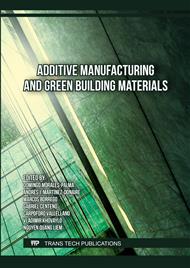p.3
p.13
p.23
p.33
p.41
p.51
p.61
p.71
Microstructure and Properties of AISI 316L Steel Processed by Selective Laser Melting Technology (SLM) and Hot Isostatic Pressing Technology (HIP)
Abstract:
The aim of our study was to determine changes in the microstructure and mechanical properties of AISI 316L steel processed by additive SLM technology which will be induced by additional processing using HIP technology and solution annealing. The specimens for this experiment were made in the form of bars with a diameter of 5 mm for tensile testing. The specimens were additively manufactured in the vertical direction with respect to the position of the build plate using standard process parameters. The HIP processing of the specimens was performed at a temperature of 1150 °C and pressure of 150 MPa. Some of the specimens were heat treated using solution annealing at 1150 °C after the SLM and HIP processes. The analyses performed consisted of metallographic analysis of the microstructure using light and scanning electron microscopy methods, which were further complemented by basic mechanical property tests, namely tensile testing and HV1 hardness measurements. The tensile test showed that the solution annealing of the printed specimens reduced the ultimate strength from 545±6.2 MPa to 508±0.0 MPa and increased the ductility from 44±5.4 % to 56±0.4 %. The HIP process reduced the ultimate strength to 522±2.7 MPa and the further annealed specimens to 514±1.8 MPa. The ductility of the specimens after HIP treatment was higher than that of the additively manufactured specimens, corresponding to 52±0.3 %. After solution annealing, it reached values like those of the specimens annealed after 3D printing. The metallographic analysis carried out showed a positive effect of the HIP process on the porosity achieved after 3d printing, whose volume was reduced as a result.
Info:
Periodical:
Pages:
13-21
Citation:
Online since:
September 2023
Authors:
Keywords:
Price:
Сopyright:
© 2023 Trans Tech Publications Ltd. All Rights Reserved
Share:
Citation:



